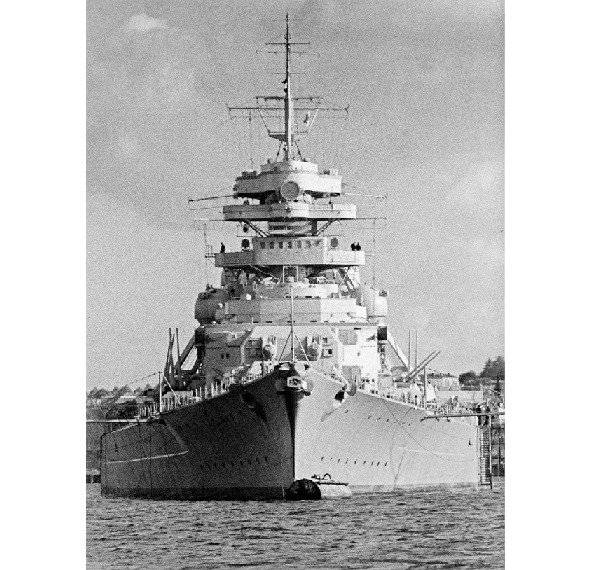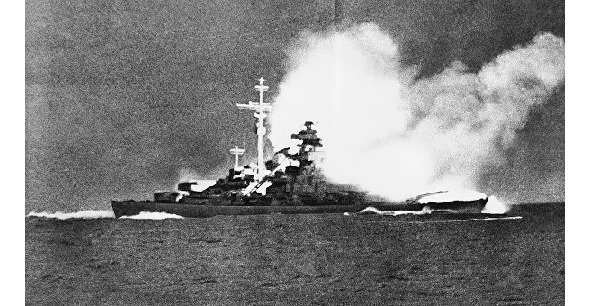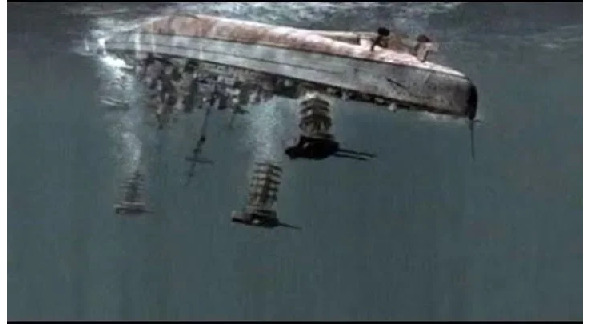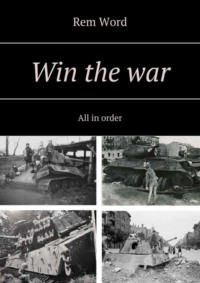
Полная версия
Diagonal encyclopedia. Bible of the Time

Diagonal encyclopedia
Bible of the Time
Rem Wоrd
© Rem Wоrd, 2021
ISBN 978-5-0051-5050-9
Created with Ridero smart publishing system
Top 5 warships on the water and the bottom

Fifth place. The German battleship Bismarck, the largest ship of its time. Displacement equipped – 50,000 tons (twice as high as that of an aircraft carrier), length 251 m, width 36 m, draft 10 m. Maximum speed 55 km. h., autonomous navigation range of 17,000 km. The main armament is eight 380 mm. cannons in four towers.

Bismarck is ready to open fire

With almost one salvo, the battleship sinks the heavy British cruiser Hood. Only three sailors are saved

Swordfish, one of the first effective torpedo bombers. Prior to that, it was believed that naval aviation was ineffective against well-armored warships. The first duel of the German battleships Scharnhorst and Gneisenau with the British aircraft carrier Glories off the coast of Norway a year earlier, ended in favor of the classic «artillery» ships

The last minutes of the super battleship. On the evening of May 24, 1941, the Bismarck receives a torpedo into the side from one of the seven Suordfish torpedo bombers that took off from the deck of an approaching aircraft carrier. The torpedo hits the armored belt (145—320 mm) and does not produce any special effect. The next day, the air attack is repeated. One of the three torpedoes damages the steering, so the ship begins to circulate. In this state, «Bismarck» has to take battle with two battleships, a cruiser and several destroyers. Roll negatively affects shooting accuracy. British shells destroy the rangefinder post and damage the turrets. The cruiser hits the super battleship with three torpedoes. The ship is turned upside down by the keel. Of the 2,220 people, 114 are saved (three are taken by the approaching German submarine).

When the ship is turned upside down by the keel, the main battery towers crumble from it.

«Bismarck» at the bottom. The depth is 4875 meters. The image is constructed from photographs taken at close range and sonar data. The survey was carried out by the British Deep Ocean Expeditions in June 2001, using Russian deep-diving vehicles Mir and a rented oceanographic vessel Akademik Mstislav Keldysh. Based on materials obtained during diving, the famous American director James Cameron shoots the film «Expedition» Bismarck»(2002)

Medium caliber towers

«Bismarck» at the bottom. Optical image

«Yamato» on the road. Fourth place. The photograph is not able to fully convey the scale of the superlinkor. By the spring of 1945, Japan has almost no combat-ready aircraft carriers. Now the war is reduced to confrontation between the Anglo-American Air Force and Japanese ships, armed only with artillery. The result of such a competition is clearly not in favor of the latter. The world’s largest battleship Yamato is sent to the shores of Okinawa to support the besieged Japanese garrison with nine powerful 460mm fire. guns.

«Yamato» in battle with the US aircraft carrier group. An artistic picture. The battleship’s displacement is 63 thousand tons, three times the corresponding characteristics of an aircraft carrier. It is 11 thousand tons higher than the Titanic. The first battle, October 22, 1944, turns out to be successful for the Yamato and four ships like it. The superlinkor opens fire on the American aircraft carrier from a distance of 27 km., And achieves hits. For one escort aircraft carrier, two destroyers and a destroyer, the Japanese pay with three heavy cruisers.

«Dountless», dive bomber, the most effective aircraft of the US carrier-based aircraft of the second half of World War II, the opponent of the Yamato. It is worth noting that thanks to the policy of free sale of old military equipment (with removed weapons) to private hands, North America has the best-preserved WW2 fleet. Including the world’s only flying attack aircraft Il-2

Photo – «Yamato» leaving the bombs, morning April 7, 1945

This time, on April 7, 1945, the Yamato and her escort were attacked by 227 carrier-based aircraft at once. The battleship receives 10 torpedo hits and 13 250-kg hits. aerial bombs. Photo – «Yamato» at the time of the explosion of one of the bombs on the deck.

A certain idea of what is happening on board the Yamato is given by a photograph of the same type of battleship Hyugu, after the bombing in August 1945, towed in shallow water

However, it remains afloat, and only an explosion in an artillery cellar of 460 mm. shells destroys the pride of the Imperial Navy. 3 thousand sailors are killed. Oddly enough, 260 people survive in the center of such a powerful, 500 tons of TNT explosion. Another 1200 people – damage to the escort group. The losses of the Americans – 10 aircraft and 12 pilots. Photo – explosion of «Yamato». Noon, 7 April 1945

In 1999, to the south of Japan (East China Sea, between Ryuku and Kyushu islands), the research vessel Ocean Voyager with two deep-sea vehicles Julia and Jim was sent. On board – a joint American-Japanese expedition. Close-up photos and sonar data provide a model for the location of the wreckage. The depth of Yamato’s resting place is 344 meters. The explosion of ammunition tore the ship in two. The place of a heap of torpedoes or aerial bombs is visible (the main part of the body is at the top)

As is customary wherever Americans operate («soft power»), research has shown impressive scientific documentaries

Third place. Armored cruiser «Varyag». We have heard the name «Varyag» many times, but the true image of the ship is little known. We will correct this error as much as possible by presenting several photos taken at the roadstead in Korean ports and Port Arthur

«Varyag» loading coal in one of the Pacific ports

The color of the pipes is beautiful orange. Admiral Rozhenstvensky accepts the proposal to repaint the ships of both squadrons in the so-called «ball» (ugly gray) camouflage color, as the Japanese did, in the spirit that the Russian fleet has its own traditions. The Varyag crew meets the news of the beginning of the Russian-Japanese war in the neutral Korean port of Chemulpo. The approaching Japanese squadron invites the sailors to either surrender or take the battle at the exit from the harbor. Dozens of ships of other powers are in the roadstead near the port. At noon on February 9, 1904, the cruiser and gunboat Koreets leave the port. An artillery duel ensues. According to the estimates of the captain of «Varyag» Rudnev, his ship fires 1000 shells of the main caliber, sinks a cruiser, destroyer and seriously damages another enemy cruiser. Own losses, in addition to the main rangefinder, ventilation systems, guns and other equipment – 30 sailors and an officer. The Japanese only confirm the damage to one of the cruisers, which is undergoing long-term repairs, and deny any damage to the personnel. According to their own calculations, the main caliber of the Varyag manages to fire only fifty shells during an hour-long battle.

The ship returns to port. At the officers’ meeting, a resolution is passed on its flooding. And, on February 9 at 6 pm, the mechanics open the kingstones. «Varyag» lays down on the ground. «Korean» (whose crew has no losses in battle) is blown up. Crews are accepted on foreign ships. Later, by prior agreement with the Japanese command, the sailors, who pledged not to take part in hostilities against the Land of the Rising Sun, go to Russia. Photo – after submersion in shallow water. Here, on the ship, the bodies of the dead sailors remain

«Varyag» immediately after the rise

The Japanese are raising and restoring the Varyag. It is now called Soy. In the First World War, Russia and Japan become allies. For a small fee, the Land of the Rising Sun returns the cruiser. In 1917, the ship leaves for Britain for repairs. How much later, with the change of power in Russia, the British confiscated it. In 1925, while ferrying to German firms for scrap, in the Irish Sea, a ship breaks off the towing cables and wrecks off the Scottish coast. Subsequently, it is blown up

The cruiser «Varyag» near the Scottish village of Lendelfoot. Last photo

The second and first places are shared equally by the American Yorktown and the Japanese Akagi. The largest, pivotal battle of the war in the Pacific Ocean, Kursk on the waves – the battle of Midway Atoll. American cryptographers break the naval code and find out that the next attack by the Imperial Navy will be carried out on the base of the Midway Atoll. Forces of the parties. Japan – 4 heavy, 2 light aircraft carriers, 300 carrier-based fighter-bomber aircraft, 16 reconnaissance seaplanes, 30 large ships (cruisers, battleships, destroyers), the main armament of which is artillery. There is no information on submarines. USA – 3 heavy aircraft carriers, 240 carrier-based aircraft, 130 – land-based, 23 combat surface ships of various classes, 16 submarines. On the afternoon of June 3, 1942, nine B-17 bombers deliver the first strike against the approaching group. However, Flying Fortresses are more suitable for destroying targets the size of a city. They do not cause damage to ships. On the morning of June 4, an attack group of 108 aircraft stormed an American ground base and inflicted significant damage on it. Ten US bombers and torpedo bombers, without cover fighters, manage to take off again. They find the aircraft carriers of the Land of the Rising Sun, attack, but almost all of them die under the machine-gun and cannon fire of the Japanese «Zero». Photo – Japanese aircraft carrier Hiryu escapes B-17 bombing from Midway Atoll

The Americans are desperate to rectify the situation. From the approaching aircraft carriers, they send new waves of Vindicator and Dontles dive bombers and Divasteyor torpedo bombers to the Japanese fleet, but they fail over and over again. The planes either do not find aircraft carriers, or fall from the fire of anti-aircraft guns and fighters. However, the pilots show courage… do not leave the line of attack under any circumstances, and this behavior impresses Fortuna. On the same hot morning of June 4, the aircraft carriers Yorktown and the Enterprise send their remaining dive bombers Dontles into battle. Groups of planes split up, lose targets, and find them again. The initiative allows you to smooth out roughness. The beginning of an attack from a great height, in cloudy conditions, goes unnoticed. Huge Japanese ships pivot to the wind to facilitate takeoff of hundreds of heavily loaded planes on the decks. At this moment, tons of American bombs fall on their decks. The aircraft carriers «Akagi», «Kaga» and «Soryu» receive catastrophic damage. According to some reports, the Nautilus submarine launches torpedoes into one of the ships two hours after the strike. In the evening of June 4 – in the morning of June 5, the aircraft carriers, having played the battle so well in the morning, go to the bottom. According to Japanese legend, the Imperial Naval Force takes five minutes to win the battle, and even the war itself. Photo – Japanese aircraft carrier Akagi after a deadly bombing raid. Noon, June 4, 1942

Somewhat outdated by 1942, but still formidable «Divasteyor». The maximum speed is 430 km. h. Defensive armament – two machine guns. Until 1944, torpedoes had to be dropped from a height of 15 m, at a speed of 200 km. h. In this case, many of the «self-propelled mines» even with a direct hit on the target (along the normal) do not explode. The speed of movement of the Japanese torpedoes is 40 knots (about 70 km. H.), The American Mark 13 – 30 knots (50 km. H.), With a cruising range of 5200 m. Practically in the same year, the Divasteyors were replaced by Avengers. Throughout the year, American scientists solve problems with non-explosive torpedoes.

The only now Japanese aircraft carrier Hiryu still has 18 equipped Val and 6 Zero bombers. Samurai attack Yorktown. Seven dive bombers break through to the American aircraft carrier and achieve three hits. 5 dive bombers and 1 fighter are returning. 10 torpedo bombers are now ready to take off. Five surviving aircraft manage to achieve two hits. Yorktown is being towed to Pearl Harbor. A Japanese submarine sinks an aircraft carrier and a destroyer covering it on June 7. Photo – Japanese torpedo bomber stubbornly breaks through to Yorktown, second half of June 4, 1942. Armament – one machine gun, one 800-kilogram torpedo.

«Aichi D3A», in American terminology «Val», a Japanese carrier-based bomber. The maximum speed is 425 km. h., three machine guns, bomb load 250 kg.

Thirsty for revenge, the Enterprise and Hornet teams assemble a group of aircraft to attack. The Americans no longer have torpedo bombers, but they have 41 dive bombers. To repel the attack «Hiryu» has only 6 «Zero» fighters that have been put into operation. The Americans are losing three planes, but getting four hits with 450-kilogram bombs. The survivability teams succumb to numerous fires in the holds. On the morning of June 5, the Japanese command gives the order to sink the heroic Hiryu. Japanese light aircraft carriers, artillery and transport ships do not take part in the battle. The main group of Japanese retreats. American planes, as far as possible in conditions of worsening weather, damage it. Losses of the parties. Japan – 4 aircraft carriers, a heavy cruiser, 250 sea-based aircraft, 2,500 personnel. USA – heavy aircraft carrier, destroyer, 150 aircraft, 350 people irrevocably. Photo – aircraft carrier «Hiryu» after the attacks of American aircraft, evening June 4, 1942

Yorktown a month before the battle… It was an era when men were men and women were women… White was white and black was black

Yorktown doesn’t seem doomed yet

Yorktown and her escort destroyer en route to Pearl Harbor, June 4, 1942

Yorktown a few hours before its death

Yorktown

«Yorktown» is laid to rest at a depth of 5 kilometers. The figure is based on the data of the 1998 deep-sea expedition.

«Akagi»
Naval battles – lessons of history

Dear friends! We all know, of course, that history lessons cannot be skipped. But there are those who believe that they already know everything perfectly in their head. Without using proven, and generally speaking, at least any sources. We must be able to educate them in a reasoned manner. To win the next war (unfortunately, peace is impossible without them), we must remember everything about our past victories and defeats. We analyze in detail one of the first naval battles of the Russian-Japanese war of 1905. Again – the cruiser «Varyag», the hero of the song of the same name, which later became the march of Russian, Soviet, and again Russian, Naval Forces. The photo above is an armored cruiser Varyag. Displacement 6600 tons, length 129 meters, width 16. Deck armor 38—76 mm. Speed 24, 5 knots (35 km. H) Cruising range 10,000 km. Crew: 550 sailors and non-commissioned officers, 20 officers. Main armament: twelve 152 mm., Twelve 75 mm. guns, six mine-torpedo tubes. Colorized, initially black-and-white photograph – «Varyag» in Chemulpo Bay, 1904. The color of the pipes is believable, and according to the «traditions of the Russian fleet» misunderstood by the admirals of the Russian Empire (RI), it does not at all contribute to the stealth of warships

By and large, on the eve of the war, Korea is a protectorate of Russia. Several years ago, the Russian Empire demanded that Japan return to China the lands of the Celestial Empire that it had conquered during the war of 1895. The samurai obeyed, but harbored a grudge. While the army and navy of the Land of the Rising Sun were modernized, and their personnel exhausted themselves on exercises, the tsarist officers considered the maneuvers unworthy of their greatness «a game of war». So, in the Chemulpo bay there are two RI warships. … It is known about Japan’s ultimatum to the Russian government. The main point is to leave Korea (after all, Koryo, the ancestral home of the samurai) alone. A state of uncertainty. Communication only via Japanese-controlled telegraph. At four days, on February 8, 1904, the gunboat «Koreets» leaves the bay to send a report to Port Arthur. Japanese destroyers (to say the least) attack the ship with two torpedoes, but miss. The «Koreets» fired several shots out of 37 mm. guns and returns to the port. It seems that this is already a war. In the evening of the same February 8, Japanese warships and transport ships disembark at the edges of the bay. «Korean» and «Varyag» do not try to prevent that. There are three reasons. First., despite all these unambiguous torpedoes, declarations of war and orders from the high command of the Republic of Ingushetia to conduct hostilities. Second, it can be taken into account that, in principle, according to some international law, the Japanese still have the right to land certain people ashore. Third, aimed at" Varyag «guns and torpedo tubes of Japanese cruisers. The commander of the cruiser, Captain Rudnev is playing for time, conferring with the officers of the British warship standing here on the roadstead, composing a note of protest. using the dark time of the day to rivet the chains, quickly un-anchor and dissolve into the night. Speed «Varyag» – 24.5 knots (or 45 kilometers per hour), exceeds the same characteristics of the best of the «Japanese» by 2—3 knots. The night passes and the unkind morning of February 9 comes. Now, finally, Captain Rudnev is waiting for the official declaration of war, and at the same time for an ultimatum from the Japanese admiral Uriu. The proposal is as follows. Leave the bay at 12 noon. Otherwise, the Japanese squadron will attack the Russian ships right at Chemulpo. Photo – «Varyag» and «Korean» go into battle. Morning February 9, 1904

Japanese cruiser Asama, the main opponent of the Varyag. Displacement 9700 tons, armor belt 88—178 mm., Speed 21.5 knots, armament four 203 mm., Fourteen 152 mm. guns, five torpedo tubes. Crew 726 people

The Japanese have six cruisers (two – armored, four armored) and three destroyers. Do they really want to attack the Russian ships in the bay? In addition to many transport ships from different countries, the port of Chemulpo is home to British, French, Italian cruisers, as well as one American gunboat. Come here, the Japanese, start scattering shells, before the whole world they will look like bloodthirsty aggressors. What will the «Mistress of the Seas» and her powerful overseas ally say to that?… Rear Admiral Sotokichi Uriu simply cannot believe his eyes when the Varyag and Korean at 11 in the afternoon, obediently, like a drake and a duck, leave the bay. Not long before that, Rudnev did not even deign to invite the captain of the Koreyets to the officers’ meeting. The gunboat commander, desperately trying to understand the elder’s intentions, joins in behind the cruiser. The speed of his ship is barely 12 knots. It is hardly possible to act effectively in such a pair. Photo – «Varyag» and «Korean» immediately after leaving the battle

…You can imagine how it should have been… Here are the captains of the «Varyag» and «Koreyets» surrounded by naval officers. «Vsevolod Fedorovich (Rudnev), we will meet the enemy here, at the base of the fairway. They will go into the bay one at a time, and will be subjected to the crossfire of our guns and torpedoes "-" Yes, Grigory Pavlovich (Belyaev), we will do so. Well, if the battle is not in our favor, I will give such and such a conditional signal. Have you recorded? By then it will definitely be evening or night. In any case, if you see that I give full speed ahead, go on a free course for a breakthrough, preferably away from me. This is how we disperse their powers. In case of destruction of the propulsion system, I officially authorize surrender… Of course, with the preliminary flooding of your ship. "Option. Both ships pull rubber until nightfall. The Japanese themselves need this… Then they go to the breakthrough in various directions, at first as quietly as possible, upon detection – scattering torpedo-shells around. Then there are many additional questions, scenarios of the future battle are being played… None of this happenedPhoto – «Varyag» and «Korean» withdraw from the battle






